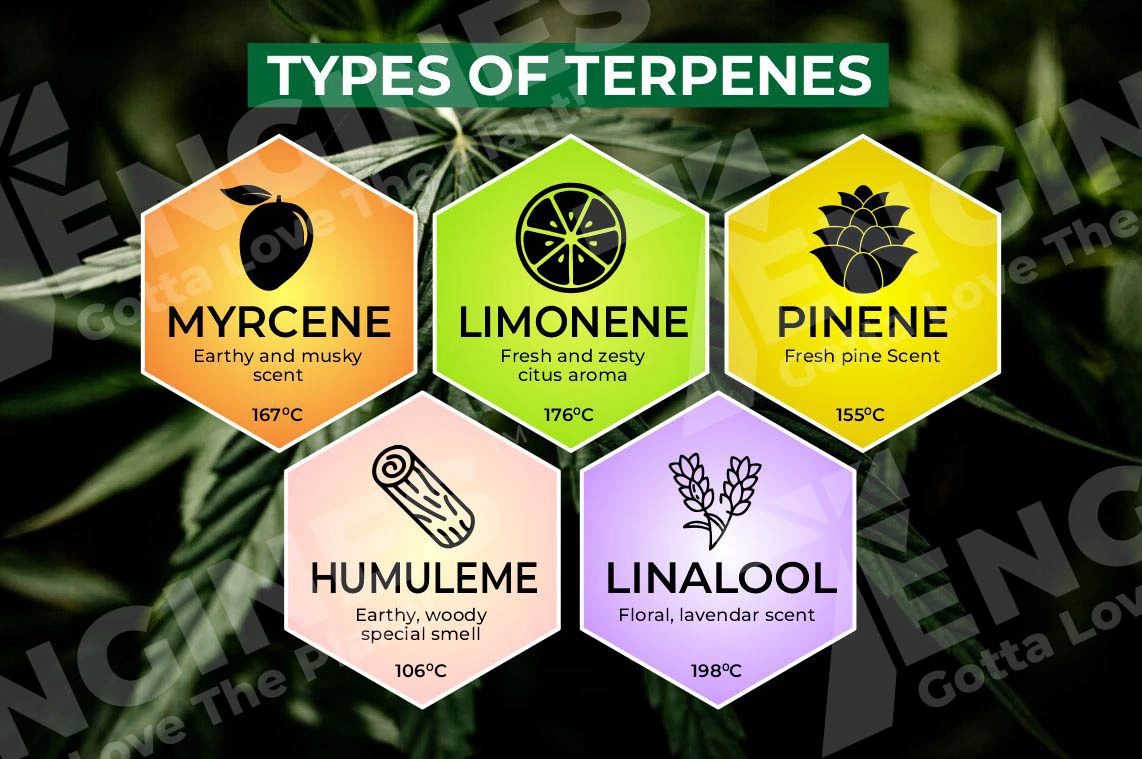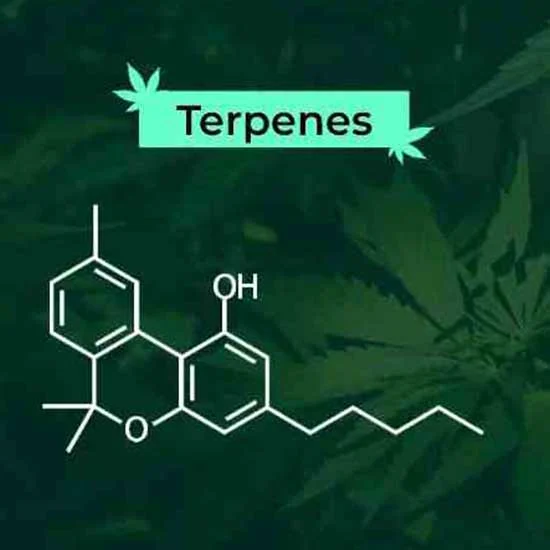The cannabis plant holds within it a world of possibilities, each strain unique in its effects and characteristics. It is the combination and concentrations of cannabinoids and terpenes within the plant that make this possible. These compounds work together in beautiful harmony, shaping the overall experience of each strain. Discover the power of these natural wonders and the limitless potential they hold. Let us learn how cannabinoids and terpenes impact the effects of different strains.
Cannabinoids
Cannabinoids, such as sativa, are a group of chemical compounds that interact with the endocannabinoid system (ECS) in the human body. The ECS is a complex cell-signaling system, which plays a crucial role in regulating various physiological processes. These include mood, appetite, sleep, immune function, and pain sensation.
The two primary types of cannabinoids, sativa, and phytocannabinoids, including terpenes and terpene, are naturally produced by the body and found in the cannabis plant. Sativa, terpenes, and terpene are the most well-known and researched cannabinoids that come from the cannabis plant. People often ask, what are terpenes and what is a terpene? These questions arise due to the growing interest in the fascinating properties of terpenes.
Cannabinoids found in cannabis include:
THC (Tetrahydrocannabinol):
- The primary psychoactive compound in cannabis.
- Responsible for the “high” associated with cannabis use.
CBD (Cannabidiol):
- Non-psychoactive and does not produce a “high.”
- Has various therapeutic properties, including anti-inflammatory, analgesic, and anxiolytic effects.
CBG (Cannabigerol):
- Non-psychoactive precursor to THC and CBD.
- Shows potential anti-inflammatory and neuroprotective effects.
CBC (Cannabichromene):
- Non-psychoactive.
- May have anti-inflammatory and anti-fungal properties.
THCV (Tetrahydrocannabivarin):
- Psychoactive in higher doses.
- Potential appetite suppressant and anti-convulsant.

Cannabinoids, the chemical compounds found in cannabis, have a fascinating interaction with the endocannabinoid system (ECS). This system consists of CB1 and CB2 receptors, which are responsible for receiving and transmitting signals throughout the body. When cannabinoids bind to these receptors, they can influence the release of neurotransmitters, which are chemical messengers in the brain.
This interaction ultimately leads to the modulation of various physiological functions. It is worth noting that the effects of cannabis can vary due to the unique combination and concentration of cannabinoids found in different strains. Whether used for recreational or medicinal purposes, individuals may experience a wide range of effects depending on the specific strain they consume.
Terpenes
Terpenes or terpene or terps, are a large and diverse class of organic compounds produced by various plants, including the cannabis plant. These aromatic molecules contribute to characteristic scents and flavors of different plant species and are known for their potential therapeutic effects.
In cannabis, terpenes, what are terpenes, what is a terpene, what are terps, are found in the same glandular trichomes that produce cannabinoids like THC and CBD. They play a crucial role in the overall chemical profile of cannabis strains, influencing the plant’s aroma, flavor, and, potentially, its effects on the body and mind.
Key aspects of Terpenes include:
Aroma and Flavor: Terpenes contribute to the distinctive smells and tastes associated with different cannabis strains. For example, strains with high levels of terpene myrcene may have an earthy or musky scent, while strains rich in limonene may have a citrusy aroma.
Therapeutic Effects: Some research suggests that terpenes may have therapeutic properties and can interact with cannabinoids to produce an “entourage effect.” The combination of cannabinoids and terpenes in a particular strain may have a more significant impact than the individual compounds alone.

Common Terpenes in Cannabis:
Myrcene: Earthy, musky, and often associated with relaxing effects.
Limonene: Citrusy and associated with potential mood-enhancing effects.
Pinene: Pine-scented and may have anti-inflammatory and bronchodilator properties.
Humulene: Earthy and woody, with potential appetite-suppressant qualities.
Linalool: Floral and lavender-scented, often linked to calming and anti-anxiety effects.
Understanding the terpene profile of a cannabis strain, along with its cannabinoid content, can provide insights into the potential effects and benefits of that particular strain. Different strains with unique combinations of cannabinoids and terpenes may offer varied experiences and therapeutic effects.
Entourage Effect
The entourage effect is a concept in cannabis pharmacology that suggests that the various compounds present in the cannabis plant, including cannabinoids, terpenes, and other phytochemicals, work together synergistically to produce a more profound and nuanced effect than what could be achieved by individual compounds in isolation. In other words, the combined action of these compounds enhances or modifies the overall therapeutic or psychoactive impact.
Key aspects of the entourage effect include:
Synergy: The interaction of cannabinoids, terpenes, and other plant compounds creates a synergistic effect where the combined action is greater than the sum of individual effects.
Modulation: Different compounds within the cannabis plant may modulate or influence the effects of each other. For example, CBD modulates the psychoactive effects of THC, reducing its intensity.
Therapeutic Potential: The entourage effect is a term used to describe the potential therapeutic benefits of using whole-plant extracts containing a diverse range of compounds found in cannabis. Such extracts may offer more comprehensive and therapeutic benefits compared to isolated compounds.
Customized Effects: The unique combination and concentration of cannabinoids and terpenes in a specific cannabis strain contribute to its distinct effects. Users can choose strains based on their desired outcomes, such as relaxation, pain relief, or increased energy.
Individual Variation: The entourage effect acknowledges that individual responses to cannabis can vary, and factors such as genetics, tolerance, and overall health may influence the experience.
While the entourage effect is widely discussed, its scientific understanding is still evolving, and not all aspects of this phenomenon are fully understood. Some research supports the idea of synergistic interactions among cannabis compounds, while additional studies are needed to uncover the full extent of these interactions and their implications for therapeutic applications. The entourage effect reinforces the idea that the effects of cannabis are complex and multifaceted, influenced by the interplay of various compounds within the plant.

Strain-Specific Effects
The cannabis plant, part of the Cannabaceae genus, has undergone refinement by generations of farmers, who selectively breed cultivars, commonly known as strains. Each strain possesses a distinct chemical profile, including cannabinoids, terpenes, and other phytochemicals, influencing its overall effects. However, variations can occur based on the growing environment and processing methods.
Traditionally, indica strains are associated with a relaxing mental effect and a “body high,” inducing a profound physical sensation. Sativa strains, conversely, provide a “head high” with primarily cerebral effects, impacting mood and emotions. Despite historical associations with specific climates, the modern understanding focuses more on the plant’s effects rather than its lineage.
Choosing the right strain involves considering the desired effects:
Indica Strains:
- Deep relaxation and potential drowsiness.
- May cause “couch lock” or physical sedation.
- Suitable for evening and nighttime use, aiding sleep and addressing physical ailments.
- Common indica strains: OG Kush, Granddaddy Purple, Wedding Cake, Purple Punch.
Sativa Strains:
- Energizing and uplifting effects.
- Best for daytime use or social occasions.
- Helpful for creative projects but may induce anxiety if overused.
- Common sativa strains: Jack Herer, Super Silver Haze, Sour Diesel, Blue Dream.
Hybrid Strains:
- Result from interbreeding indica and sativa plants.
- Effects vary based on parent strains, offering a balance of indica-like or sativa-like effects.
- Bred for specific combinations of THC, CBD, cannabinoids, and terpenes.
- Well-known hybrid strains: Sundae Driver, Runtz, Gelato, Cookies.
CBD Strains:
- Non-intoxicating, offering benefits such as pain relief and stress reduction.
- No mind-altering effects, making it suitable for those not seeking a high.
- Varies in THC levels; a higher CBD percentage reduces psychoactivity.
- Popular CBD strains: AC/DC, Penny Wise, Ringo’s Gift, Harle-Tsu.
In comparing indica, sativa, hybrid, and CBD strains, indica provides relaxing and sedative effects, while sativa offers mind-altering and energizing effects. Hybrids combine characteristics of both, and CBD strains focus on therapeutic benefits without the psychoactive high.
Due to extensive cross-breeding, true indica or sativa strains are rare, and most available strains are hybrids. Farmers can tailor highly specialized strains by isolating specific characteristics through breeding and pheno-hunting. Understanding the cannabinoid and terpene profiles can provide insight into a hybrid strain’s potential properties.
Popular Strain Effects
Understanding different marijuana strains is vital for achieving the desired effects, whether for recreational or medicinal purposes. Below is a breakdown of popular strains and their associated effects:
Acapulco Gold:
Origin: Acapulco, Mexico.
Effects: Known for inducing euphoria and providing an energizing effect, it is reported to alleviate fatigue, stress, pain, and nausea.
Blue Dream:
Effects: Recognized for its relaxing and soothing properties, it offers pain relief, mood elevation, and a sense of euphoria.
Purple Kush:
Effects: Creates a blissful and relaxed state, promoting happiness and sleepiness. They are often used for pain relief and muscle spasms.
Sour Diesel:
Effects: Highly energizing with mood-lifting and productive energy qualities. It is known for destressing and providing pain relief.
Bubba Kush:
Effects: Induces relaxation and sleep, offering relief from pain and stress. Particularly suitable for addressing insomnia.
Granddaddy Purple:
Effects: Highly relaxing, effective against insomnia, stress reduction, euphoria, and appetite stimulation.
Afghan Kush:
Origin: Hindu Kush mountains.
Effects: Super relaxing and sleep-inducing, stimulating appetite, and relieving pain.
LA Confidential:
Effects: Relaxing, sleep-inducing, anti-inflammatory, and effective in reducing pain. Often used for insomnia.
Maui Wowie:
Effects: Promotes a super relaxed yet energetic and creative state and reduces fatigue.
Golden Goat:
Effects: Notable for inducing euphoria, enhancing creativity, reducing fatigue, and relieving stress.
Northern Lights:
Effects: Relaxing, sleep-inducing, mood-lifting, and effective against insomnia, pain, stress, and depression.
White Widow:
Effects: Improves mood, boosts energy, induces relaxation, and provides pain and stress relief. Helpful for managing feelings of depression.
Super Silver Haze:
Effects: Energizing, euphoria-inducing, pain and nausea relief, and mood elevation.
Pineapple Express:
Effects: Relaxing, mood-lifting, and provides an energetic buzz, suitable for enhancing productivity.
Fruity Pebbles (FPOG):
Effects: Induces euphoria, promotes relaxation, relieves stress, induces giggly feelings, reduces nausea, and increases appetite.
In conclusion
The world of cannabis strains is diverse and complex, with effects shaped by the interplay of cannabinoids and terpenes. The traditional classifications of indica, sativa, and hybrid are being reconsidered, as these terms may not accurately predict the effects of a particular strain. The entourage effect highlights the importance of the synergistic interaction between cannabinoids and terpenes, creating a nuanced and personalized experience for users.
As users explore different strains and understand the compositions and overall effects of cannabis strains, responsible exploration and awareness of personal tolerance levels are essential for an enjoyable and safe cannabis experience.
As research in cannabis pharmacology continues, individuals are encouraged to stay informed about the evolving understanding of cannabinoids, terpenes, and their combined effects. Whether for medicinal or recreational use, the diverse world of cannabis offers a multitude of options, each with its distinctive characteristics and potential benefits.
The information provided is not a substitute for professional medical advice, diagnosis, or treatment. Consult with a qualified healthcare professional for personalized advice based on your medical condition.




